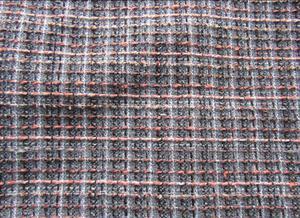The Application of Fancy Thread in Home Textiles
1. Home textile products follow fashion trends
Home textiles mainly refer to household indoor necessities and decorations, with a wide variety of types, including bedding, curtains, coverings (such as sandpaper), flooring, wall stickers, kitchen utensils, decorations, etc. In addition to practical functions, home textile products also have the function of beautifying the living environment, creating a good atmosphere, and reflecting the owner's taste.
With the synchronous improvement of people's living standards, the change in consumption concepts has not only expanded the quantity and space of home textiles, but also formed the pursuit of quality and fashion for home textiles. Home textile products, like clothing, have trendy fabrics and colors.
2. Application of fancy yarns in household textiles
Bedding category: The application of fancy yarns injects fashionable vitality into bed decorative fabrics. The product is designed according to popular trends and targeted at different countries and consumers. Some use fancy yarn entirely, while others use it locally. Combined with jacquard and printing techniques, it adds trendy elements to the bed decoration fabric, giving people a comfortable, warm, high-end, and elegant feeling.

Curtain fabrics: Fancy yarn curtains have elegance and beauty. In the high-end interior decoration fabrics of the United States and Western Europe, a large amount of fancy yarn is used, especially in recent years, the market space for fancy yarn interior decoration fabrics is very large. Taking curtains as an example, curtain fabrics developed using three-dimensional knot yarn, looped yarn, chenille yarn, bamboo yarn, and other techniques such as warp knitting, distressed printing, printing, and jacquard weaving are elegant in color, trendy in design, environmentally friendly in raw materials, and classic and fashionable in patterns, giving people a pleasing and irresistible feeling.
Wall mounted fabrics: Fancy yarn wall coverings are the fourth generation wall covering products, which are used in residences to showcase elegance and fashion, and in hotels, guesthouses, and commercial buildings to showcase aristocratic taste.
Batch covering fabrics: Furniture decorative fabrics woven using chenille thread or coarse knot, circular composite fancy thread, paired with classical jacquard weave, and reasonably matched with popular colors, used for various sofas, cushions, seats, etc., which are popular in some European countries and the United States.
3. Requirements of household textile trends for fancy yarns
The development space of the home textile industry both domestically and internationally is enormous, and products that meet fashion standards will have higher requirements and stricter standards. From the market experience and product innovation direction of production enterprises, the use of fluffy structure and dynamic changes in color, as well as variations in yarn thickness, can produce a three-dimensional layered effect, or form color layering changes caused by color changes, which can form products that conform to popular trends and have market competitiveness.
Article source: Fancy Thread Manufacturer
-
05-27
The reason why fabrics containing spandex are prone to yellowing
Spandex is a commonly used fiber variety in our daily lives, characterized by good elasticity, low fineness, high elastic modulus (cracking elongation can reach 400-800), and low specific gravity. Spa
-
04-24
Colored non dyed nylon with synthetic fiber raw material
The current conventional fiber coloring mostly uses yarn dyeing method, which has long process, high loss, high cost, and the product has color difference and low color wash fastness. Yarn is prone to
-
03-26
What are the characteristics of non dyed spandex?
Non dyed spandex has also been widely used in recent years. Non dyed spandex fiber can be blended with fibers such as nylon, polyester, acrylic, cotton, wool, etc., which can give fabrics excellent el
-
02-24
The influence of yarn structure on fabrics
The basic characteristics of yarn include its appearance and shape, twisting characteristics, fiber transfer and distribution characteristics in the yarn, as well as the surface fuzz and internal loos
